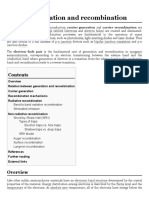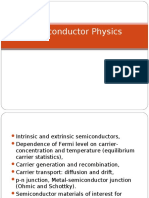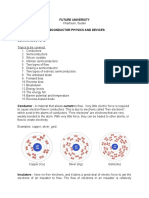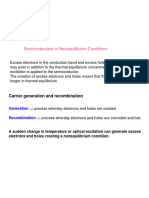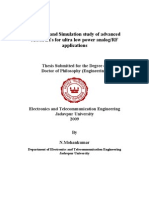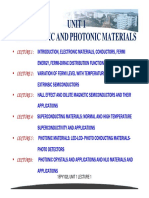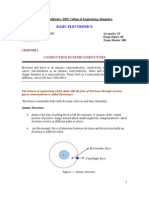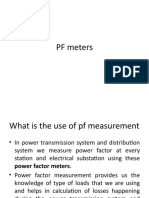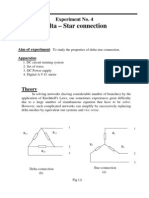0 ratings0% found this document useful (0 votes)
1K views24 pagesApplied Physics Notes
semiconductors
Uploaded by
jeevan01g1Copyright
© © All Rights Reserved
We take content rights seriously. If you suspect this is your content, claim it here.
Available Formats
Download as PDF or read online on Scribd
0 ratings0% found this document useful (0 votes)
1K views24 pagesApplied Physics Notes
semiconductors
Uploaded by
jeevan01g1Copyright
© © All Rights Reserved
We take content rights seriously. If you suspect this is your content, claim it here.
Available Formats
Download as PDF or read online on Scribd
You are on page 1/ 24
UNIT
SEMICONDUCTOR PHYSICS
SIA GROUP
PART-A
SHORT QUESTIONS WITH SOLUTIONS
Q1, Define semiconductor.
Answer :
‘A semiconductor is a substance for which width of the forbidden energy region is relatively small (i., = 1 eV). The
conductivity of semiconductor is much greater than that of an insulator because, the number of free electrons in a semiconductor
lies im the range of 10° to 10. Figure below shows the energy band structure of a semiconductor.
Q2._ Define intrinsic semiconductor.
Answer + Model Paper-t, atte)
Intrinsic Semiconductor
‘This type of semiconductor is made out ofthe semiconductor material in its extreme pure form.
Example
Ge and Si which have forbidden energy gaps of 0.72 eV and I.1 eV respectively.
‘When an electric field is applied to an intrinsic semiconductor at a temperature greater than OK, conductor's electrons
move to the anode and also the holes in the valence band move to the cathode.
‘An intrinsic semiconductor may be defined as in which the number of conduction electrons are equal to the number of
holes.
Conduction Band
Fermi
000000 level
oo 0
Wiese band
Figure: Energy Band Diagram of an Intrinsic Semiconductor
Room Temperature
‘SPECTRUM ALL-IN-ONE JOURNAL FOR ENGINEERING STUDENTS ——————————— SIA GROUP.
2.2
APPLIED PHYSICS [JNTU-HYDERABAD]
Q3, Given the expression for carrier concentration
of an intrinsic semiconductor.
Answer t
‘The expression for carrier concentration of an intrinsic
‘semiconductor is given by,
PAT’ exp [- E/kyT
Where,
4-contrt ae af
T~ Ambient temperature
E, Energy gap of the semiconductor=E,~ F,
E.~ Conduction band energy level
E,- Valance band energy level
,~ Boltzman constant,
Qé._ Give the classification of extrinsic semiconduc-
tors.
Answer :
Depending on the type of doping material, extrinsic
semiconductors are classified as follows,
Bxrrinsic
semiconductors
—
Neype Paype
semeonluctors semicondctors
@ N-type Semiconductors
N-type semiconductors are obtained by adding
pentavalent impurities like Phosphorous, Arsenic (other
ppentavalent clements) etc, to pure (or intrinsic) semiconductors.
‘The electrons are the majority carer in an N-type semiconductor.
‘They are also called as donor type semiconductor, because they
are capable of donating an electron,
(ii) P-type Semiconductor
When impurities like Aluminium, Boron and other
trivalent clements are added to a pure semiconductor a P-type
semiconductor is formed. In this type of semiconductor, large
number of holes are present and thus this type is always ready
to accept electrons. Hence, it is also known as acceptor type
semiconductor.
QS. Mobilities of electrons and holes in a sample
of intrinsic Ge at 300 K are 0.36 m? V+ S“ and
0.17 m? V" S$“ respectively. i the resistivity of
the specimen Is 2.122 m, compute the intrinsic
concentration of carriers for Ge.
Where m*= 0.5 m, and m;,= 0.37 m,
Answer
Given that,
For a Ge semiconductor,
‘Operating temperature, T= 300K
Mobility of electrons, = 0.36 m? VS!
Mobility of holes, y,= 0.17 m! F'S*
Resistivity of specimen, p= 2.12.m
Mass of electron, m! 0.5 m,
Mass of proton, njf =0.37 m,
‘Then, the expression for intrins
of a semiconducting material is.
pen, 7H.)
2121 @xi0x[036+0.17)
$02 « 10 m?
= 5.502 10" m?
Q6. Given the expressions for carrier concentration
of N-type and P-type semiconductors,
Answer :
‘The expression for carrier concentration of an N-type
semiconductor is given by,
1N_ —Number of carriers in conduction band
E, — Fermi level energy
E, ~ Conduction band energy level
7 — Ambient temperature
4, Boltzmann constant
‘And the expression for carrier concentration of a P-type
semiconductor is given by,
Nie Niora| Hef
N, —Number of carriers in valence band
nergy level,
Q7. Explain conceptoffermilevelin semiconductors.
Answer
‘The energy level that an electron can reach or occupy
ina material at absolute zero temperature is referred as fermi
level in semiconduetors. The position of fermi level depending
con the type of semiconductor used i.e.,
1. Forintrinsic semiconductor, the fermi level iselose
to the middle of band gap.
2. ForNetype semiconductor, the fermi level is close
to the conduction band.
3. For P-type semiconductor, the fermi level iselose
to the valence band,
Look for the SIA GROUP LOGO J} on the TITLE COVER before you buy
UNIT-2 Semiconductor Physics 2.3
Q8. Define carrier transport.
Answer :
Carrier ransport is a process IN which motion of free carriers TAKES PLACEin a semiconductor leading to a current.
‘This process occurs due to the thermal energy and are related to random motion of the carriers
The two basic transport mechanisms are drift and diffusion.
The movement of charge due to electric field is known as drift while the flow of charge due to density gradient is known
as diffusion
9. What is Hall effect?
Answer
When a current carrying semiconductor bar is kept in a transverse magnetic field, an electric field is produced within the
semiconductor. The direction of generated electric field is perpendicular to both the current and applied magnetic field. This pro-
‘cess is referred to as Hall effect. Duc to the generated electric field, a voltage is developed across the surfaces of semiconductor
bar known as Hall voltage,
Q10. Define diffusion and drift currents.
Answer :
Diffusion Current
‘The flow of charge carriers from a high-density region to low-density region constitutes diffusion current. This flow occurs
until the distribution of charges becomes uniform, in both the regions. Diffusion is a temporary process, unless the charges in the
higher concentration regions are refilled, continuously.
Drift Current
‘Whenever voltage is applied to the PN junetion, there exist a flow of current because of applied voltage and this eurrent
is known as drift current.
Q11. Distinguish between Drift and Diffusion current.
Answer :
Drift Current Diffusion Current
1. [Drift current occurs duc to an applied electric | 1. | Diffusion current occurs even though an electric
field. field is not applied.
2. | tdepends upon permittivity 2. | Itis independent of permittivity
Direction of drift current depends on the polarity | 3. | Direction of diffusion current on the change in
of the applied field. the carrier concentration.
Q12. What Is a PN-junction diode? Draw the symbol of a PN-junction diode.
Answer ¢ Model Paver2, te}
PN-Junction Diode
APN junction diode is a two terminal semiconductor device, which consists of a PN-junction formed ever a semicon-
ducting material.
It is formed by joining a P-type semiconductor to an N-type semiconductor as shown in figure (1).
Figure (1: Schematic Diagram of PN-Junction Diode
SPECTRUM ALLIN-ONE JOURNAL FOR ENGINEERING STUDENTS $1 GROUP “>
24
APPLIED PHYSICS [JNTU-HYDERABAD]
‘Symbol of PN-Junction Diode
‘The circuit symbol of a PNejunction diode is as shown
in figure Q),
Arrow head
J Ba
Anode 5 £ Cathode
P
Figure 2 Circuit Symbol of a PN Juneton Diode
‘The P-region is referred to as anode while the N-region
is referred to as cathode, The arrow head indicates the direction
cof current flow in the diode
Q13, Mention the applications of PN junction
diode.
Answer :
Applications of PN-Junction diode are a follows,
1, PN-Junetion diode is used as rectifiers to convert ac to
de in de power supplies.
2. Tis used for clamping networks of voltage multipliers
and television receivers.
3. Ibis used as a switeh in digital cieuits
4, Ibis used in demodulation circuits,
[iy used in clipping circuits,
Q14. What is a zener diode?
Answer + ‘Mode! Paper.3, a1(e)
Zener Diode
‘The power dissipated at the junction of a normal PN
diode operating in breakdown region is very lange. Due to
large power dissipation, the diode gets damaged. The diode
‘which is designed to operate in breakdown region under certain
conditions is known as zener diode. Zener diode is heavily
doped than normal PN junetion diodes.
(or)
A heavily doped PN-junction diode, which always
remains in reverse-biased condition is known as zener diode.
A zener diode is represented by the symbol as shown in
figure
Anode Cathode
Figure: Zener Diode
Q15, Draw the V-I characteristics of a zener diode.
Answer
‘The Vl characteristies of Zener diode are shown in
figure.
> Viforward)
‘V(Reverse)
Figure: Vl characteristics of Ze
Q16. List the three applications of zener diode.
Answer
Applications of zener diode are,
1 Voltage regulator
Clippers
3. Clamping circuits
4 Surge processors... ete
Q17. What is bipolar|unction transistor and mention
its types?
Answer Model Paper, atid)
Sunetion Transistor
A Sjunction transistor’ or “Bipolar Junction Transistor
(BJTY or simply ‘transistor’ is a thtee terminal solid state
semiconductor device. It is basically a semiconductor crystal
formed by joining two back to back PN junctions. These
jjunetions are arranged such thet, one type of semiconductor
layer (n-type or p-type) is sandwiched between two layers of
the opposite type of semiconductor. The term “bipolar’ in the
‘name indicates the involvement of both majerity and minority
cearies in its operation.
Types
There are two types of JT's
1 PNP
2 NPN,
Look for the SIA GROUP LOGO {J} on the TITLE COVER before you buy
UNIT-2, Semiconductor Physics 2.5
Q18, Draw the symbols of PNP and NPN transistors.
Answe
‘The symbols of PNP and NPN transistors are shown in figure (1) and (2) respectively
4 4
Figure (1): NPN Transistor Figure (2): PNP Transistor
Q18. List the applications of transistor.
‘Answer :
1. tis used in amplifier eireuits
2. Itis used in oscillator circuits.
3. Tis used as a switch in digital circuits.
4. Itfinds many applications in computers, satellites and modern communication systems,
‘SPECTRUM ALL-IN-ONE JOURNAL FOR ENGINEERING STUDENTS 5] GROUP
2.6 APPLIED PHYSICS [JNTU-HYDERABAD]
PART-B
ESSAY QUESTIONS WITH SOLUTIONS
2.1 INTRINSIC AND EXTRINSIC SEMICONDUCTORS:
Q20. Briefly explain about the classification of semiconductors with suitable examples.
Answer
‘Semiconductors ean be el
ified imo two groups. They ate as fllows,
1. Intrinsic (or) pure semiconductors
2. Extrinsic (or) impure semiconductors
1. Inttnate Semleonduetors
02.
2, Extrinsle Semiconductors
For answer refer Un
The intrinsic semiconduetors to which some suitable impurity (or) doping agent has been added in extremely small amount
are called extrinsic semiconductors.
Case 1
‘The doping agents are pentavalent atoms having five valence electrons in their outer most orbit (or) trivalent atoms
having three valence electrons in the outer most orbit. Pentavalent doping atom is known as donor atom because it contributes,
fone electron to the conduction band of pure germanium,
Case Tt
‘Trivalent atom is called as acceptor atom because it accepts one electron from the germanium atom.
Finally, depending on the type of doping material used, extrinsic se
They are as follows,
ductors can be further divided into 1wo groups.
(a) n-type semiconductors
ond
b)_peype: ns
Q21. Distinguish between intrinsic and extrinsic semiconductors.
Answer Model Paper-t, 40)
‘The differences between intrinsic and extrinsic semiconductors is mentioned below
Intrinsic Semiconductors Extrinsic Semiconductors
1. [in ‘semiconductor is a pure form of | 1. | Exirinsic semiconductor is an impure form of|
semiconductor. semiconductor,
2. | The electrical conductivity of intrinsic | 2. | Extrinsic semiconductor has higher clectrical
semiconductor is relatively low. conductivity.
3, [Number of holes is equal to number of | 3, | Number of holes is not equal to number of|
clectrons in intrinsic semiconductor. electrons in extrinsic semiconductor,
4, | In intrinsic semiconductors, conductivity | 4. } In extrinsic semiconductors, conductivity is|
is increased by increasing the temperature, increase by adding small amount of impurities to
intrinsic semiconductors through doping process.
Sroup-IV elements such aserystals | $. | Example: Crystals of germanium and silicon
silicon and Germanium, doped with impurities such as As(Arsenic),
Sb Antimony) and P(Phosphorus)
5. | Example:
of pu
Look for the SLA GROUP LoGo gj} on the TITLE COVER before you buy
UNIT-2 Semiconductor Physics 2.7
22, Explain the need for doping and discuss different type
Answei
‘The process of adding impurities to the crystal of an intrinsic (pure) serniconductors is called doping. Generally, at room
temperature semiconductors do not conduct electricity and act as insulators. So, some amount of impurities must be added to them
to imbalance the covalent bonds of erystal structure to make them conduct. Therefore, the impurity added is called ‘Dopant’ and
the doped semiconductor material is called ‘extrinsic semiconductor’. The conductivity of intrinsic semiconductors inereases due
to doping and in practice, extrinsic semiconductors ae preferred for making various electronic devices such as diodes, transistors,
ete
Based on the type of impurities used, the extrinsic semiconductors are classified as follows,
1. N-type semiconductor
2. P-type semiconductor,
1, Netype Semiconductors
'Ntype semiconductors are obtained by adding pentavalent impurities like Phosphorous, Arsenic (other pentavalent elements)
cle. (0 pure (or intrinsic) semiconductors, The electrons are the majority cartier in an N-type semiconductor. They are also called
as donor type semiconductor, because they are capable of donating an electron,
“The concentration of impurity atoms added to the pure semiconductor is very small, such that one peatavalent impurity
atom is surrounded by 4 atoms of Ge (or) Si {pure semiconductor). The S valence electrons of impure atoms are shared by 4 Ge
(01) Si to form covalent bonds. The exira 5® clectron of the impure atom can be dislodged by supplying small range of energies
(0.01 eV 10 0.05 eV). Hence, free electron exists for every impurity ator. Thus, the number of electrons ate high in this type of
semiconductor.
Figure (1) shows the covalent bond between a pentavalent impurity atomn Ar and Ge.
2, P-type Semiconductor
‘When impurities like Aluminium, Boron and other trivalent elements are added to a pure semiconductor a P-type
semiconduetor is formed. In this type of semiconductor, large number of holes are present and thus this type is always ready to
accept electrons. Hence, itis also known as acceptor type semiconductor
‘The impuritics like Aluminium, Boron and other trivalent atoms have three valence electrons and sare as incase of N-type
semiconductor, each impure atom is surrounded by four Ge (or) Si atoms.
‘The three valence electrons form covalent bonds with three Ge(or) Si atoms and the fourth Ge(or) Si atom has no electron
{0 form a bond with the impure atom, So, when sufficient energy is supplied, the electron deficient bond gets the electron from
the nearby bond, this way the electrons moves in one direction which is nothing but movement of hole in the reverse direction
(o that of electrons. In this way, hole moves and generates hole euient.
SPECTRUM ALLIN-ONE JOURNAL FOR ENG NEERING STUDENTS SIA GROUP @
Figure (2) shows the covalent bond between a ti
APPLIED PHYSICS [JNTU-HYDERABAD]
lent impurity Al and Ge.
Figure Covalent Bond between Aluminium (Al and Germanium (Ge)
‘mtype Semiconductor
23, Describe the difference between n-type and p-type semiconductor materials.
‘Answer + Model Paper, Q1(a)
Pelype Semiconductor
1. n-type semiconductors are obtained by adding
pentavalent impurities (like phosphorous, Arsenic)
to pure semiconductors.
2. | These are also known as DONOR type semi-
conductors, because they are capable of donating
electrons.
3. | Electrons are the majority charge carriers.
4, | teconsists of 5 valence electrons,
5] Electrons move and generate electron ewrent.
Pelype semiconductors are obtained by adding|
trivalent impurities (like Aluminium, Boron) to]
pure semiconductors.
These are also known as ACCEPTOR type|
semiconductors, because they are ready to ae-|
cept electrons,
Holes are the majority charge carriers,
I consists of 3 valence electrons,
Holes move and generate hole current.
at room temperature (27°C). Given, K =
Answer :
Given that,
For an intrinsic semicondieto:
Band gop, £, = 0.7 6V
Room temperature, 7= 27°C
Boltermann’s constant, K~ 1.38% 102 J/K
Planck's constant, = 6.62» 10-3
Model Papert, (0)
Then, the expression of hole density in an intrinsic semiconductor is given by,
1 fam, 7 Fe
Pal ae | “PL ar
1 f2%1.6610 1.38107
4] 5x (6.6210)
= «(9.983 «10898 » 1,782 « 10%
= 14.052 « 10" m?
p= 14.052 « 10" m
2x16x1!
1.3810 « 300
Look for the SIA GROUP Loco Qf on the TITLE COVER before you buy
).7 eV, calculate the density of holes and electrons
1B x 10-2 JK and h = 6.62 « 10 J.
UNIT-2 Semiconductor Physics. 2.9
‘And the expression of electron density in an intrinsic semiconduetor is given by,
4
oJ
=0.7x1.6 x10"
=0.7 1.6107)
1.38%10 7 300
jf esses at ate
= exp]
1m (6.62104P
= 4px (54.727 « 104)? «1.78210
= 4 408958 10" 1.782 10°
804 * 10" m?
= 1.804 10" mr?
2.2. DEPENDENCE OF FERMI LEVEL ON CARRIER CONCENTRATION AND TEMPERATURE
25, Explain the dependence of fermi level on carrier concentration,
Answer
Fermi Energy on Carrier Concentration
‘The number of allowed k-values per unit volume of k-space of the material with volume v is number of energy levels in
fermi sphere.
Consider two spin values for each k-values,
w= 28tkee W)
For Nelectrons, volume Vis,n~ 4
= ve SE win euy= EE
= An) Hexen}! oD
‘Using Bolzmann approximation to the fermi distribution then, the carrier concentration in conduction and valence band
are,
fone seat
nen Nee HG” p= Fee“ BP 23)
For intrinsic, E, = £, te P, =, then equation (3) can be written as,
4)
3)
Answer t Mocel Paper-2, Q4(a)
Ferm Energy
Femi energy refers to the energy of the highest oceupied quantum state in a system of Fermi ions at absolute zero
twmperature, This energy level decreases as the temperature inereases, The expression for Fermi energy is given by,
Ey -ak,T
SPECTRUM ALLIN-ONE JOURNAL FOR ENGINEERING STUDENTS SIA GROUP 4b
2.10
APPLIED PHYSICS [JNTU-HYDERABAD]
Where,
1 ~Constant
K,,~ Boltzmann constant
7 —Temperature atthe junction.
‘Temperature Dependence of Fermi Energy
Fermi energy at any temperature (other than K) is to
find out by using Fermi-dirac function because the probability
of finding the electrons at any energy levels above £, is finite
‘The number of free electrons per unit volume in the metal is,
a [28 {Eye
Where,”
E) ~ Density of sates office electrons
. et 1
foe 2m gt Ty EET e
aon bele
Evaluate above integral and use the approximation that
E-E,>> KT, we get,
z 2(4r)
££, |! = (4
The factor (#] is very small, So the temperature
dependence of £, is almost insignificant. Therefore, Ean be
treated as almost constant
Q27. Explain the variation of Fermi level with tempera-
ture in the case of p-type semiconductors.
Answer:
‘Temperature Dependence of Fermi Level in P-type Semi-
conductor
‘The expression for earrier concentration in the case of
P-type semiconductor is given by,
rs
Te esate a One
£8, -wrl | 0)
Ny
For a P-type semiconductor at room temperature,
P =N, equation (1) becomes as,
As Tincreases, the doping becomes less important than
the thermal generation of carriers £, tends to E,
For a P-type semiconductor,
ae,
ar
‘The variation of Fermi level with temperature ina P=
type semiconductor is shown in the following figure.
>0
>t
|____=,
Eq
al a
Y
Fqure
Q28. Explain the Fermi's level in intrinsic semicon-
ductor.
Answer =
Inanintrinsc semiconductor materials the concentration
‘of electrons is equal to the concentration of holes.
np, a
When *7 indicates intrinsic.
‘The concentration of electrons ‘n’ and holes *p’ in a
semiconductor material at a temperature *7” is given as,
ete)
(2)
e)
Look for the SIA GROUP LOGO {i on the TITLE COVER be‘ore you buy
UNIT-2. Semiconductor Physics 2.11
‘And mi, m, are effective mass of electron and hole ‘Where,
emvecinely om (nn. *PH,Je 2
Equations (2) and (3) are valid for both intrinsic and
extrinsic semiconductors.
Substituting equations (2) and (3) in equation (1),
Taking logarithm on both sides,
Ne | +E) -2Ep
Ny iT
Ny,
= pte ae +
ae Teste,
ft Ey aT
20° 2 Ny
@
Ifthe effective masses of fre electron and hole are same,
= Ns then equation (4) becomes,
Fork,
i (3)
Hence, the Fermi level lies atthe center of forbidden band
in the case of an intrinsic semiconductor as shown in figure.
Condon baad
Cotes
& TOK RK
B v2 E
T= 000%
The current density “J” of @ semiconductor is given by.
I= (1+ PH, OE o
-oE
From equations (1) and (2) we observe thatthe electrical
characteristics of a semiconductor material depends on the
concentration of fiee electrons ‘n° and holes ‘p"
‘The concentration of electrons ‘n' and holes ‘pin a
semiconductor material at a temperature 7" is given as,
eet)
a- Nee 7 =O)
pr Nye aa)
Where,
Equations (3) and (4) are valid for both intrinsic and
‘extrinsic semiconductors.
The only parameter in equations (3)and (4) that changes,
for extrinsic semiconductors is the fermi energy level, £,- For
‘an intrinsic semiconductor, £, lies in the middle of the energy
2p indicating equal concentration of electrons and holes. Ifa
donor type impurity is added to the semiconductor then, at a
given temperature and assuming all donor atoms as ionized,
the first N, states inthe conduction band will be filled
Hence, it is more difficult for an electron from the
valence band to bridge the energy gap by thermal agitation. As
result, the number of electrons, hole pairs thermally generated
for that temperature will be reduced.
Since the fermi level is a measure of the probability of
‘occupancy of the allowed energy states, it is clear that £, must
move closer to the conduction band to indicate that many of the
‘energy states in that band are filled by the donor electrons and
fewer holes exist in the valence band. This is shown in figure
(1) for an N-type material
«
inc bd
coe
(1 Position of Fermi Level in Netype Material
For an N-type material,
n=N, 8)
‘SPECTRUM ALLIN-ONE JOURNAL FOR ENGINEERING STUDENTS
SIA GROUP
2.12
APPLIED PHYSICS [JNTU-HYDERABAD]
‘Substituting equation (5) in equation (3) and evaluating,
etn
NotNce o
Seog
Mp
O
The same kind of argument lead to the conclusion that.
E, must move from the center of forbidden gap closer 10 the
valence bend fora P-type material as shown in figure (2).
Conta a
ih:
wo
Figure (2k: Posito
af Form Leval in P-type Semiconductor
For a Ptype material,
PEN, ®
Substituting equa
(8) in equation (4),
ero) eo
Ny
Taking logarithm on both sides,
ne. Ee-Ey
XW
Q30. Derive an expression for the carrier concentration
of an intrinsic semiconductor.
‘Answer :
1m a semiconductor, two types of fee charge carrier:
exist ie., electrons in the conduction band and holes in the
valence band, In general, i s taken thatthe conduction band
is extended from E, to + 2 and the valence band is extended
from to E,
(®) Computation of Electron Density
Let ‘abe the number of electrons per unit volume of a
homogeneously doped semiconductor erystal in equilibrium.
If the conduction band extends from to, then the electron
density can be written as,
nm feEVe (EME oD
In this integral, the energy F being considered is always
‘greater than E_. If temperature T is E, ~ £,, S SK, then the
‘expression reduces to,
y? (EE,
1
ae,
Substituting x ue
KT
dE = Kyiv and(E~ Fey? = (KT Cy
Substituting the above values and changing the limits
in equation (2),
2m,
e
2m,K T y d
From standard mathematical tables,
flora
yi DOCK Tide
a
Substituting equation (4) in equation (3),
Look for the SIA GROUP LoGo {Jf on the TITLE COVER before you buy
UNIT-2 Semiconductor Physics
if ‘2am, mse) |
At
omic anual" fF cal
n= (2
(3)
(0)
Which is called the effective electron density in the
conduction band,
Gi) Computation of Hole Density
Let p be the number of holes per unit volume of @
homogeneously doped semiconductor erystal in equilibrium. IP
the valence band extend from ~ 2° to £,, then the hole density,
pina homogeneous doped semiconductor ean be written as,
f
= fen) apt) ae o
L_ (2m ¥ 2
But, 10-3 aay a
2a
And p(E)=
Henee,
Tle :
In general, the energy E'being considered always lesser
than £,, Ifthe temperature is such that &,,—&,. 2 SK,7:
= B)!2dE (8)
wed
Substituting the above values and changing the li
in equation (8),
2 Tay cg he
= ( yi 8 (ary
rae OMEY LAPP om
From standard integrals,
joer at
ne
(10)
‘Substituting equation (10) in equation (11),
p -afamecat Y! (72) ny
i
see)
Where,
Nea emeey’ «2
Which is known as effective hole density in the valence
band
From mass-xetion law,
2.14 APPLIED PHYSICS [JNTU-HYDERABAD]
) (n,m, )¥*is « constant value of semiconductor and £, ~ £, ~ Bis the energy gap of the
Itis to be noted that 4 and , are constants for a given semiconductor and a, i ealled the incinsic concentration which
indicates thermally generated electrons and holes, Itis a strong function of temperature 7:
Q31. Ifthe effective mass of holes ina semiconductors 5 times that of electrons, at what temperature would
the fermi level be shifted by 15% from the middle of the forbidden energy gap. [Given that the energy
gap for the semiconductor is 1.20 eV].
Answer : Mode! Paper2, 2410)
Given that,
For a semiconductor,
Energy gap, £, = 12 €V
Effective mass of holes = 5 Eifeetive mass of electrons
m,
eum,
Intrinsic fermi level shifted by 15% from the middle of the forbidden energy gap i,
Ep, Exitgp ~ 154%!
=0.15 «06
= 0.09
ME 5 ~ Ent. gap)
ote]
40.09% 1,002%10-"”
‘3K138x10 x In]
= 805.55 K
T= 805.55 K,
2.3 CARRIER GENERATION AND RECOMBINATION, CARRIER TRANSPORT : DIFFUSION
AND DRIFT
Q32. Define carrier generation and recombination.
Answer : Model Papers, aria)
{In an instrinsic semiconductor, generation and recombination of carrier occurs when an electron makes a transition from
the valance band to a conduction band andl results an interaction with other electrons, holes, photons or the vibrating crystal
lattice. This process conserves both quantized energy and momentum,
Generation of Carrier
The process whete pairs of electron-hole are created or generated by exciting an electron from the valance band of the
semiconductor o the conduction band thereby creating a hole in a valence band.
Recombination of Carrier
Itis a reverse process of generating carrier In this process electrons and holes from the conduction and valence band are
recombined and the remaining free electrons and holes gets eliminated when free electrons in the conduction band falls on to
hole in the valence band,
Look for the SIA GROUP Loco Gf} on the TITLE COVER before you buy
UNIT-2 Semiconductor Physios
933, Explain carrier dritt,
Answer +
A process in which motion of free cartier ina semiconductor is due an externally applied electric field, This transportation
process is known as carrier ctift. The motion of carrier drifting in a semiconductor is shown in figure s
igure (1)
Consider that all the carriers in the semiconductor moves with same average velocity then, the total charge on the
semiconductor is divided by the time needed to travel from one electrexe to other.
1228 “0
wer,
1, Transmit time of a particle
v= Velocity
fames
‘The expression for current density J can be rewritten as the function of the charge density p,
ye gt-a 2)
Fer mpitly arg cron
Current density, J = = gnv 0
For positively charged holes, J = gnv oA)
The carrier motion in the semiconductor in the absence and in the presence of an electric field can be visualized as,
ero
Bx Eek
Figure (21
Before applying electric field, the earriers in a semiconductor exhibits random motion and moves quickly by frequently
changing its direction, Similarly, on applying electri field, cartier move randomly in addition, there is an average net motion
along the direction of the field. This is due to different electronic change, holes moves on an average in the direction of applied
ficd while electrons moves in the opposite direction,
SPEGTRUM ALLIN‘ONE JOURNAL FOR ENGINEERING STUDENTS SIA GROUP (>
2.16
APPLIED PHYSICS [JNTU-HYDERABAD]
Consider only average velocity, # of the carriers by
applying Newton's law,
Thus, the acceleration of the carrier is proportional to
the applied force ie,
F=mi=m 4p ~6)
The force consists of difference between the
clectrostatie foree and the scattering force duc to the loss of
‘momentum atthe time of scattering. Thus,
(T)
(0)
Where,
¢— Charge on particle
4¢—Collisions
Equating equations (5) and (6),
ge= mf, mie) “O
The steady state in which the particle accelerates and
reaches a constant velocity resulting,
& =)
‘Thus, from the above equation, mobility of a particle
in a semiconductor is expected to be large if its mass is small
and the time between scattering events is lange.
Equation (2) can be written as a function of mobility
as,
For electrons, J, = gmi,e
Forholes, J, = qpipé
Q34, Explain carrier diffusion.
Answer
Carrier diffusion is due to thermal energy KT (nor net
current in a material with uniform carrier) that causes carriers
to move at random even when no field is applied. This random
motion neither produce a net flow of carriers density. In this
process, diffusion of carrier take place from the high density
rogion to the low density region.
The random nature of thermal energy used inthis process
is related by three averages, ie.,
L
42 «a
Where,
V,,~ Thermal velocity
1 Mean free path
1, ~ Collision time
“To derive diffusion current expression, consider variable
cartier densities n(x) with one mean free path which arrives at
= Oand originates either atx = — for. =
Atx=0, cartier originate at.x=— and moves ftom left
toright,
Q)
aaa Hail
Whore, factor {represents only half fhe cares
‘moves to left while the remaining half moves to right.
Similarly, At x = 0 when carriers originates at x =~
and moves from right to left.
ange nia” Marlx= 2) ~@)
‘The total flux of carrier moving from left to right atx = Oi,
8. Baca gn Brana alr = 0) b=]
4
‘The charge of an electron can be written as,
J,--44,- Ws ©)
Replacing thermal velocity, V, and mean fice path, by
‘a common single parameter diffusion constant D,
For electrons,
J-@, &
Similarly for holes,
ok
From thermodynamics, electrons cat
yond
jes thermal
‘energy which equals A for each degree of freedom for one-
dimensional,
AD m*¥a
ao
‘The product of thermal velocity and the mean free path.
as the function of carrier mobility ean be written as,
q
y. He _ KT
m,- mg #
‘The above relation is referred as Einstein relation
KE...
For p type D,= ty A= yh,
Form type, Dy~ iy A= ipl
Look for the SLA GROUP Loco {i on the TITLE COVER before you buy
UNIT-2 Semiconductor Physics
2.17
Q35. Discuss the different types of current component
mechanisms in semiconductors.
Model Paper3, 8
OR
Explain drift and diffusion current.
Answer :
‘The current flowing through a semiconductor material
are of two types namely,
(Drift current
Gi) Diffusion current
The net current through the semiconductor is
of Drift and diffusion currents.
@® Drift Current
‘Whenan clectrc field is applied across the semiconductor,
the charge carriers (electrons and holes) acquire a certain
drift velocity ¥, As a consequence the electrons move
towards the positive terminal of the battery and holes
move towards the negative terminal ofthe battery. This
movement of charge carriers constitutes a current known
as the “Drift current”.
the sum
Thus, the drift current is defined as the flow of electric
current due to the motion of the charge carriers under
the influence of an extemal electric field
The drift current density due to free electrons is given
by,
7 em E
‘The drift current density due to holes is given by,
J.-M
Where,
sn Number of free electrons/em?
p—Number of holeslem!
11, Mobility of electron
H,~ Mobility of hoes
¢— Charge of electron
E- Intensity of applied electric field
The total drift eurent density flowing through semicon-
ductor matcral is,
SETA,
= Irom E+ epaE
I~ (mn, + PH ee
(Diffusion Current
In a semiconductor material charge carriers have the
tendeney to move from the region of higher concentration
to thatof lower concentration, For instance, in an N-type
material ifthe concentration of holes is greater in one
region as compared to rest of the region as shown in
figure
SPECTRUM ALL-IN-ONE JOURNAL FOR ENGINEERING STUDENTS.
‘Then holes move from the region of higher concentration
to that of lower concentration until the concentration of
holes is equal in the entire region.
Are
Hele ‘N-ppe material
Figure: An N-Type Material with Concentration Gradient in Holes
This movement of charge carriers due to the concen-
tration gradient constitutes a current called “Diffusion
Current”.
‘Thus, the diffusion current is defined as the flow of
electric current due to concentration gradient
‘The diffusion current density due to free electrons is
sven by,
to
J.-D, 2 Nem
Where,
D, ~ Diffusion coefficient for clectrons
an
4 _ Concentration gradient for electrons in
a ®
x-direction
¢ ~ Charge of electron
‘The diffusion current density due to holes is given by,
bass
J,- ed, © Neri
1, Dy
Where,
D, - Diffusion coefficient for holes
ra
®B ~ Concentration gradient for holes in x-direction
a ras
e ~ Charge of electron.
Total diffussion current density flowing through the
material i,
Jad td,
on op ®
= sre, Bae
dn ®
p,#-p, 2
FOO ae
‘SIA GROUP
2.18
APPLIED PHYSICS [JNTU-HYDERABAD]
2.4 HALL EFFECT
Q36, What is Hall effect? Deduce the expression for
Hall coefficient in case of a semiconductor.
Answer t Model Paper-2 ate)
Hall Effect
For answer refer Unit-2, Q9.
Expression for Hall Coefficient
Hall Coefficient of p-type Semiconductor
When a p-type semiconductor bar is placed in a
transverse magnetic field, an electric field is established in the
direction normal to both magnetic field and current “7. Figure(i)
shows the p-type semiconductor bar, which is aligned with the
coordinate system.
y
Probe contacts
(op and down)
Figure i)
‘The magnetic force F, exerted by the holes on applica-
tion of magnetic field ‘3° is given by,
Fin eBy, ~@
Where,
¢ ~ Charge of electron or hole
¥,~ Average drift velocity of holes.
Due to the electric field generated, holes experience an
electric foree “F," and is given by,
F,-eE @
At equilibrium condition, the electric force *F, balances
the magnetic force *F,” ie.
F,-F,
> beh,
= By, @
Ith wid ofthe type semiconductor bare then
the electric field intensity can be written as,
From equations (3) and (8),
v
ye
ay,= sf (3)
For a p-type semiconductor, surface ‘I* will be more
positive compare to surface “2°. Then, the expression for cur-
rent density of holes is given by,
que ©)
Substituting the value of“
tion (5),
1)
sw
BIW.
¥,- 7
‘u- be om
rom equation (6) in equa-
But, the Hall coefficient is defined as,
=
Be
R=
=
4
1 Cepepe)
a Cie
advat
Rum pe =p
Hall Coefficlent of n-type Semiconductor
When a n-type semiconductor bar is placed in a trans-
verse magnetic field, an electric field is established in the
direction normal to both magnetic field and current ‘I". Figure
Gi) shows the n-type semiconductor bar, which is aligned with
the coordinate system.
Figure ti)
Look for the SIA GROUP Loco Qf on the TITLE COVER before you buy
UNIT-2 Semiconductor Physics
2.19
he magnetic force F, exerted by the ele
tion of magnetic field +2" given by,
Fo eBV,
appli
Where,
‘¢—Charge of electron or hole
Average drift velocity of electrons.
Due to the electric field generated, electrons experience
and eleeirie foree “F,’ and is given by,
F.= ck
rium condition, the electric force *F,
Atequi p
the magnetic force “F," ie,
> e)
Ifthe width ofthe n-type semiconductor bar is “1”, then
the electric field intensity ean be written as,
an
w
“
From equations (3) and (4),
¥,
py, ots
1, = oft 6)
For a mtype semiconductor, surface *1' will be more
negative compate to surface “2". Then, the expression for cur-
rent density of electrons is given by,
)
Here, ‘~ ve" sign indicates that the eharge of electrons
is negative.
Substituting the value of *¥;" from equation (6) in
equation (5),
4
o
-1 pane}
Q37. What is Hall effect and derive the expression
for the Hall coefficient, carrier concentration
and mobility?
Answer : Model Paper-1,a8(a}
Hall Effect and Expression for Hall Coeffictent
For answer refer Unit-2, Q36.
Carrier Concentration
For p-type semiconductor,
Where,
p~Hole concentration
For n-type semiconductor,
1
Hall coefficient, &,,= — =
ne
Where,
Electron concentration
‘Therefore,
wget
pane
Mobility
For patype semiconductor,
Conduietivity, = pew,
Where,
4, Hole mobility
For mtype semiconductor,
Conductivity,
eu,
Where,
i, ~ Electron mobility
Son,
Wee Fe 7 Ry
Therefore,
= oR,
HTH OR,
‘SPECTRUM ALLIN-ONE JOURNAL FOR ENGINEERING STUDENTS
SIA GROUP ae
2.20
APPLIED PHYSICS [JNTU-HYDERABAD]
Q38. Explain the applications of Hall-effect.
Answer :
Applications of HalleefTeet
1, Determination of Type of Semiconductor
The sign of the Hall coefficient depends on the type of
semiconductor placed in the transverse magnetic field. Hall
coefficient is negative for an n-type semiconductor and positive
fora p-type semiconductor. Therefore, from the sign of the Hall
coefficient we can determine whether a given semiconductor
1s norp-type.
2. Calculation of Carricr Concentration
Concentration of the cart
bar placed in the magnetic field can be determined using the
expression,
Where,
Bis the magnetic flux density in Wo/m?
1, is the current flowing through the semiconductor bar
“b's the width ofthe bar and
*¥," isthe Hall voltage.
measured by placing two probes
tom surfaces of the semicondue-
The Hall voltage ‘¥,
atthe centers of the top and!
tor bar.
3. Determination of Mobility
Assuming thatthe flow of current in the n-type semicon-
ductor bar placed in the magnetic field is only due to majority
carriers, that is, electrons, we have,
o = nH,
°
WATT OR,
vu
1
Knowing 0, we can determine the mobility 1,
Since, Ry,
Similarly, we can determine u_ by placing a p-type
semiconductor bar in the magnetic fel
4. Hall Effect Multiplier
‘Ifthe magnetic field “8” (in which the semiconductor bar
is placed) is produced by an air-core coil carrying a current 7
through it, then B is proportional to”, The Hall voltage which
is product of B and 1, (/is the current flowing through the
bar will now be product of/ and J. This forms a basis of the
multiplier,
2.5 P-N JUNCTION DIODE, ZENER DIODE
AND THEIR V-1 CHARACTERISTICS
239, What is p-n junction diode? How it is formed?
Draw the energy band diagram of an unbiased
P-n junction diode.
Answer Model Paper-3, Q4(t)
PN-Junction Diode
APN-junction diode is a two terminal semiconductor
device, which consists of a PN-junction formed over a
semiconducting material
‘Symbol of PN-Junction Diode
The circuit symbol of a PN-junction diode is as shown
in igure (1),
Arrow head
Anode Cathode
Figure 1): Gireuit Symbol of a PN-Junction Diode
‘The P-region is referred to as anode while the N-region
is referred to as cathode. The arrow head indicates the:
‘of current flow in the diode.
Formation of PN-Junction Diode
APN-junction diode is a two terminal semiconductor device,
‘which consists ofa PN-junction formed overa semiconducting.
‘material, PN-junetion is formed when two extrinsic semicon-
ductors (one P-type and one N-type) are doped into a semicon-
‘ducting material, such as Germanium or Silicon.
Figure (2) represents the formation of a PN-junction
diode,
During the formation of PN-junction, the free electrons
from N-region diffuse into the P-region to combine with hol:
Look for the SIA GROUP Loco Qf} on the TITLE COVER before you buy
UNIT-2. Semiconductor Physics
2.21
This combination of holes with free electrons creates a
ncgative potential (i... negative charge caries) at P-side near
the junction,
Similarly, the holes from P-tegion diffuse into the
‘Neregion to combine with electrons.
This combination of free electrons with holes ercates a
positive potential (ie., positive charge carriers) at N-side near
the junction. Therefore, the region near the junction becomes
free from change carriers. This region of immobile positive and
negative charge carters at the junction is known as depletion
layer (or) depletion region, The depletion region acts as a bar-
rier and thus prevents further motion of charge earriers near the
junction, This potential difference possessed by the depletion
region at the PN-junction is called barrier potential (V,).
Q40, What do you understand by depletion region at
PN junction? What is the effect of forward and
reverse biasing of PN junction on the depletion
region? Explain with necessary diagram
Answer :
Depletion Region
In a PN junction P-type consists of holes and N-lype
consists of electrons. Figure (1) shows the PN junction with
Patype on lel side and N-type on right side,
4 GXoeotetioa resin
10/01 Oe
ae | > Froe cloctrons
oO
Gee
Figure (1)
Due to diffusion, the large number of holes from let side
diffuse to right side and simiarly, the lange number of electrons
from right side diffuse to left side.
Due to this displacement, P-side losses holes and forms,
‘a ncgative electric field to the let side of junction and N
losses electrons and forins a positive elecitic Geld to the right
side of the junetion. Because of this large movement of holes
and electrons, a barrier potential is developed across the
junction. Finally, the holes will eombine with free electrons
and gets disappear leaving negative potentia| at P-side near the
Junction. Similarly, the fice electrons will combine with holes
‘and gets disappear leaving positive potential at N-side near
the junetion. This region at the junction is known as depletion
region
The thickness of depletion region is the order af few
rmierons,
Where,
1 micron = 10 em,
Forward Bias
epivien rgb
Figure (2)
In forward bias, the thickness of depletion layer is very
thin because p-type is connected to positive terminal and tho
retype is connected to the negative terminal. This causes the
holes and electrons to move freely across the junction, hence
resulting in a large current,
Reverse Bias
Figure (3)
Inreverse bias, asthe p-type is connected to the negative
terminal and n-type is connected to the positive terminal, the
force of attraction takes place, so the holes from p-side and
the electrons from n-side moves avy from the junction, thus
increasing the width of depletion region, This results ina very
lice curren, almost equal to zero. Therefore, in reverse bias
the thickness of the depletion layer is large.
O41. Explai
diode.
‘the volt-ampere characteristics of PN
Answer :
PN Junction under Forward Bins
Figure (1) shows the V-1 characteristic ofthe PN junetion
diode.
Figure (1): VA Characteristics of Junction Diode
“The forward curent J will be zero because the forward
linge is ncromed ta Pree by the potential baie il
nov prevents the holes for P-egion and cleerons fom N-egion
to flow across the depletion layer but in opposite direction.
IfV;> V, the barricr will completely disappear and by this
the holes will cross the P-region and enters to Neregion and the
You might also like
- U23CS351-Problem Solving Using C LaboratoryNo ratings yetU23CS351-Problem Solving Using C Laboratory141 pages
- The Inverse Laplace Transform Partial Fractions and The First Shifting TheoremNo ratings yetThe Inverse Laplace Transform Partial Fractions and The First Shifting Theorem5 pages
- Basics of Semiconductor Materials - With Notes100% (1)Basics of Semiconductor Materials - With Notes57 pages
- Clipper and Clamper Circuits: January 2012No ratings yetClipper and Clamper Circuits: January 201223 pages
- Ldr/Photo Diode/Photo Transistor Characteristics Trainer Model No. ITB - 27100% (1)Ldr/Photo Diode/Photo Transistor Characteristics Trainer Model No. ITB - 2720 pages
- PHY2 GTU Study Material E-Notes Unit - 4 15032021082835AMNo ratings yetPHY2 GTU Study Material E-Notes Unit - 4 15032021082835AM19 pages
- DIP126EN - Applied Physics-II 28-02-2022No ratings yetDIP126EN - Applied Physics-II 28-02-2022226 pages
- Homo and Hetero Junction Semiconductor Diode LasersNo ratings yetHomo and Hetero Junction Semiconductor Diode Lasers9 pages
- Accident Prevention For Vehicles in Ghat RoadsNo ratings yetAccident Prevention For Vehicles in Ghat Roads30 pages
- Draw Input and Output Characteristics of A JFET (BFW10) PDFNo ratings yetDraw Input and Output Characteristics of A JFET (BFW10) PDF7 pages
- Fundamentals of Electricity and Electronics Model Question Paper100% (1)Fundamentals of Electricity and Electronics Model Question Paper1 page
- Degenerate and Non Degenerate SemiconductorsNo ratings yetDegenerate and Non Degenerate Semiconductors4 pages
- Extrinct Semiconductors and PN JunctionNo ratings yetExtrinct Semiconductors and PN Junction30 pages




